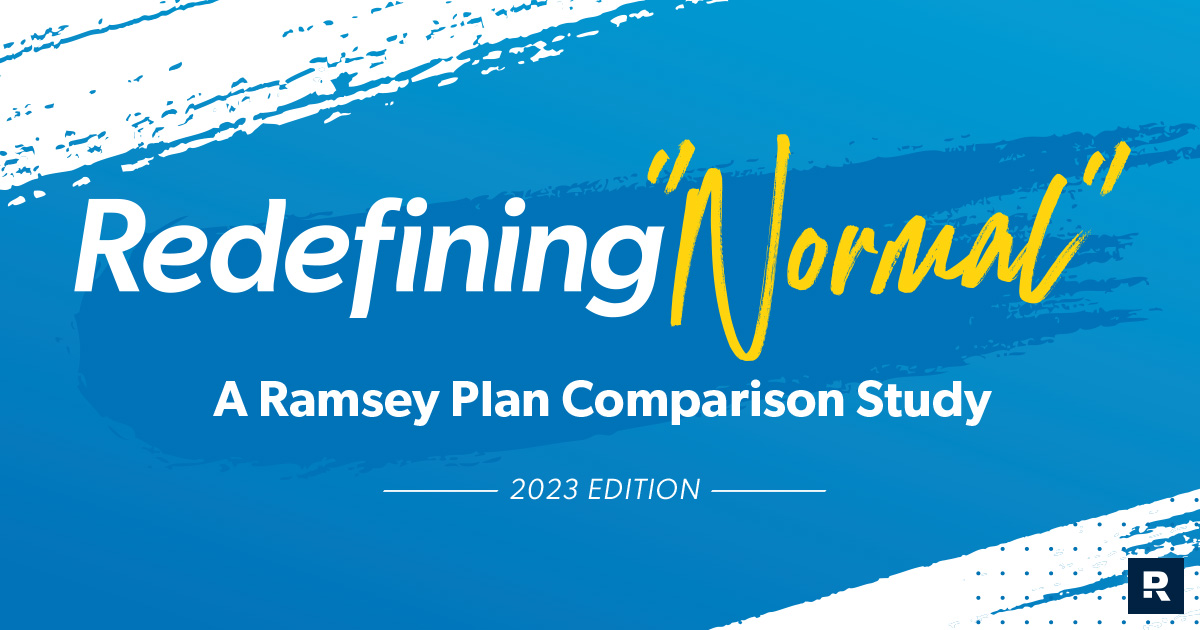Introduction
For almost 30 years, Ramsey Solutions has been teaching people to take control of their money and change their family trees using time-tested biblical principles. These principles are captured in Ramsey’s 7 Baby Steps—a step-by-step financial plan that bucks the “normal” culture’s toxic approach to money and leads to long-term financial success.
 Over the decades, we’ve heard from thousands of people who have followed the Baby Steps and built real generational wealth for themselves and their families. From their stories, we know these Baby Steppers are generally happier and more confident about their futures than those following the “normal” cycle of endless debt and paycheck-to-paycheck living.
Over the decades, we’ve heard from thousands of people who have followed the Baby Steps and built real generational wealth for themselves and their families. From their stories, we know these Baby Steppers are generally happier and more confident about their futures than those following the “normal” cycle of endless debt and paycheck-to-paycheck living.
Now, in this comparison study, we’re using a data-driven approach to examine the results of the Baby Steps—looking at statistics from both serious Ramsey Baby Steppers and the general U.S. population to measure the behavioral and emotional differences between the Ramsey way and the “normal” way of handling money.
Executive Summary
- 84% of Baby Steppers describe themselves as intentional when it comes to money, compared to only 48% of the general population—a 36 percentage point difference.
- 1 in 3 Baby Steppers said they live paycheck to paycheck, compared to half of the general population.
- While almost half of Americans (43%) are having trouble paying their bills, only 20% of Baby Steppers are experiencing the same difficulty—a difference of over 20 percentage points.
- About a third of the general population (32%) said they’re finding it difficult to pay for food. Meanwhile, only 16% of Baby Steppers said the same.
- People who follow the Baby Steps are half as likely to struggle with paying rent than the general population (26% vs. 50%).
- When it comes to mortgages, the general population is three times more likely to have trouble making their payments than Baby Steppers (38% vs. 11%).
- Baby Steppers are twice as likely as the general population to say they’re thriving financially (25% vs. 12%).
- 43% of the general population said their personal finances have had a negative impact on their mental health compared to only 31% of Baby Steppers.
- About half of the general population (51%) worry about their personal finances daily. However, only 37% of Baby Steppers worry about money every day.
- People who follow the Baby Steps are less likely than the general population to lose sleep (23% vs. 39%), cry (19% vs. 34%), or have an anxiety attack (22% vs. 35%) due to money troubles.
- As people progress from one Baby Step to the next, positive feelings go up exponentially. The biggest improvement is in feeling fulfilled (17% in Baby Step 1 to 50% in Baby Step 7—nearly three times greater).
- Negative feelings such as stress, worry and dissatisfaction decrease considerably as people progress through the Baby Steps. Worry drops the most—from 45% in Baby Step 1 to 7% in Baby Step 7.
- 64% of Baby Steppers are either very or extremely optimistic about their financial future, compared to only 38% of the general population.
- 90% of Baby Steppers said they can overcome their money challenges, while just 59% of the general population said the same.
- 74% of Baby Steppers believe they can become a millionaire—something most Americans consider a pipe dream. Only 33% of the general population believe they can reach millionaire status.
- Over half of Baby Steppers (54%) are extremely hopeful about achieving their money goals. Only 28% of the general population feel the same.
Behavioral Differences
As Dave Ramsey has taught for almost three decades, winning with money is 80% behavior and 20% head knowledge. Knowing what to do is not nearly as important as actually doing it—implementing changes that go against the grain of a money culture designed to keep people broke. Overall, people who follow the Baby Steps have embraced the behaviors they need to make lasting change in their finances.
Ramsey Baby Steppers Are Better Organized With Their Money
People who follow the Baby Steps are more likely to be focused when it comes to their money and their long-term money goals.
Get expert money advice to reach your money goals faster!
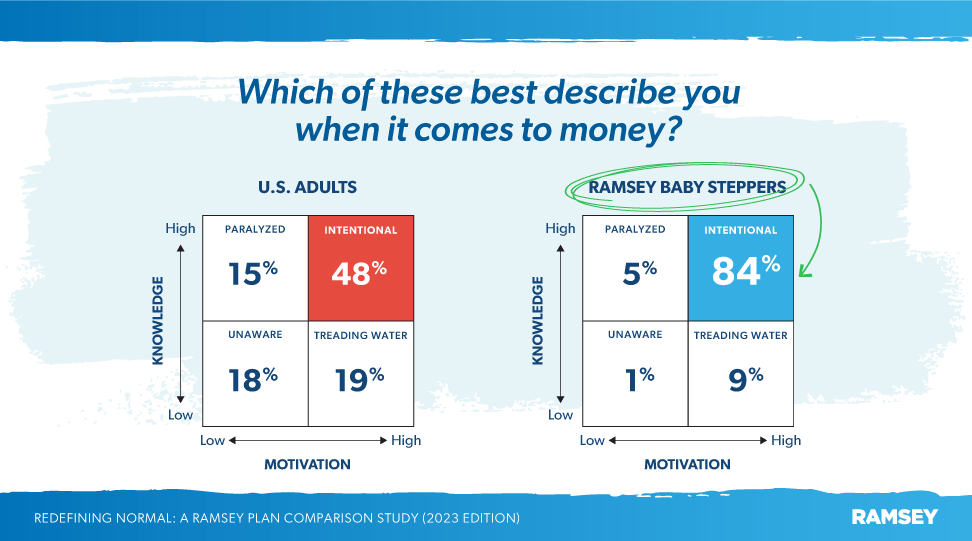
Eighty-four percent of Baby Steppers describe themselves as intentional about money, compared to only 48% of the general population—a 36 percentage point difference. Baby Steppers are also less likely to categorize themselves as paralyzed, unaware or treading water with money.
As a result, only 1 in 3 Baby Steppers said they live paycheck to paycheck, compared to half of the general population.
Baby Steppers Demonstrate Better Money Behaviors
Baby Steppers were also more likely than the general population to rate themselves as good or great at 19 of 20 financial behaviors, including:
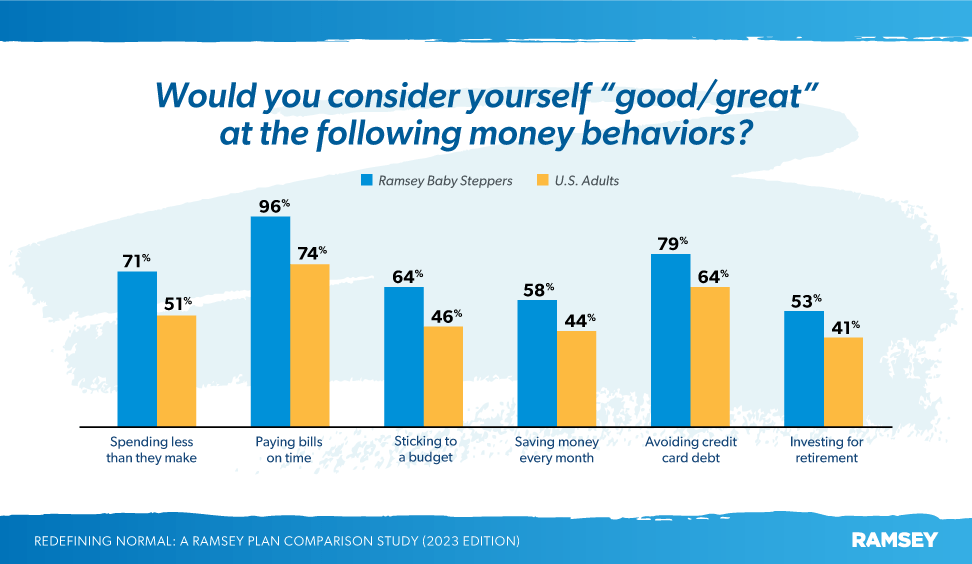
General Population Is More Likely to Struggle Paying Bills
While inflation continues to cool from its record pace in 2020-2022, people are still feeling its effects. Many are struggling to make ends meet and keep current on their bills.

While almost half of Americans (43%) are having trouble paying their bills, only 20% of Baby Steppers experience the same difficulty—a difference of over 20 percentage points.
Providing food is another financial pain point for many Americans, with about a third of the general population (32%) saying they’re finding it difficult to do. Meanwhile, only 16% of Baby Steppers are in the same boat.
The trend is similar for housing as those costs get higher and higher. People who follow the Baby Steps are half as likely to struggle to pay rent (26% vs. 50%). And the gap is even larger with mortgages—the general population is three times more likely to have trouble with their mortgage than Baby Steppers (38% vs. 11%).
More Baby Steppers are Thriving
Because Baby Steppers are committed to following the Baby Steps with intentionality, it’s no surprise they’re more likely to thrive—even in an uncertain economic situation like we’re experiencing now. Baby Steppers are twice as likely as the general population to say they’re thriving financially (25% vs. 12%).
Emotional Differences
Money touches nearly every aspect of life, and that can make it a powerful source of stress. Money stress can affect your mood, your sleep, your relationships—your entire outlook on life. But what if you didn’t have to worry about money anymore? Would you be less stressed? More optimistic? Based on the data, that’s true for people who follow the Baby Steps.
Baby Steppers Are Less Likely to Experience Negative Impacts on Mental Health
Forty-three percent of the general population said their personal finances have had a negative impact on their mental health compared to only 31% of Baby Steppers.
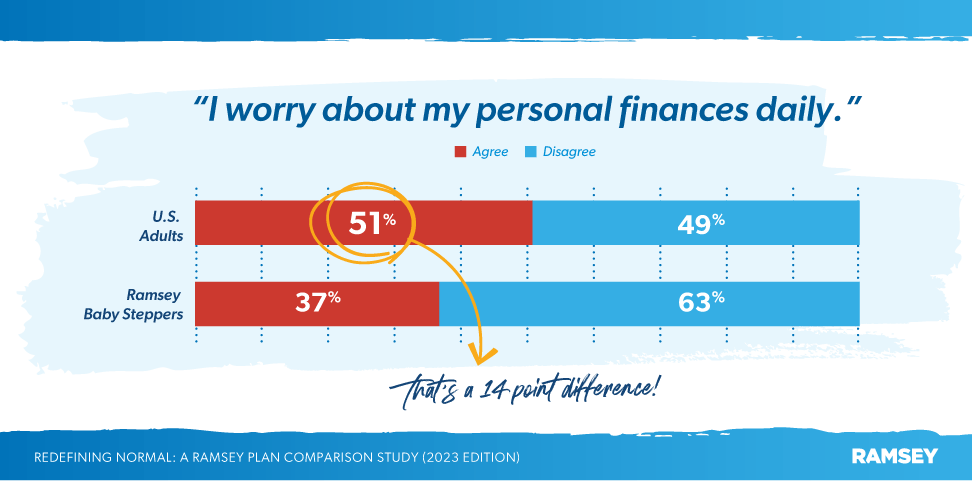
About half of the general population (51%) worry about their personal finances on a daily basis. However, only 37% of Baby Steppers do the same. This is also true for outward signs of money stress and worry. People who follow the Baby Steps are less likely than the general population to lose sleep (23% vs. 39%), cry (19% vs. 34%), or have an anxiety attack (22% vs. 35%) due to money troubles.
Ramsey Plan Progress Promotes Positive Feelings
One of the hallmarks of the Ramsey Baby Steps plan is people can see and feel the progress they’re making. That optimism and hope encourage them to stick with the plan.
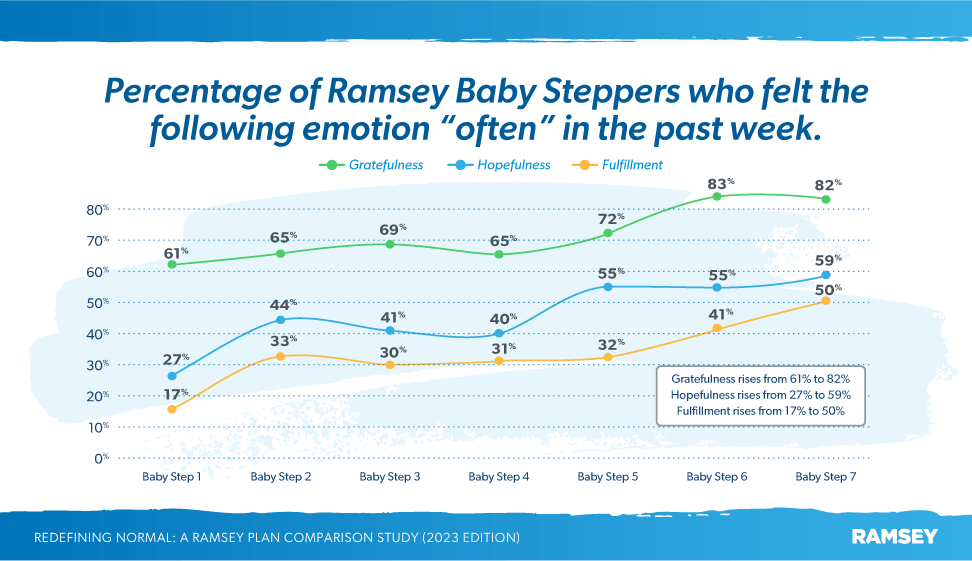
As people progress from one Baby Step to the next, feelings of gratitude, hope and fulfillment increase exponentially. The biggest improvement of these factors is fulfillment (17% to 50%—nearly three times greater). Baby Step 2, where people pay off their consumer debt, results in the largest jump in feelings of hope and fulfillment.
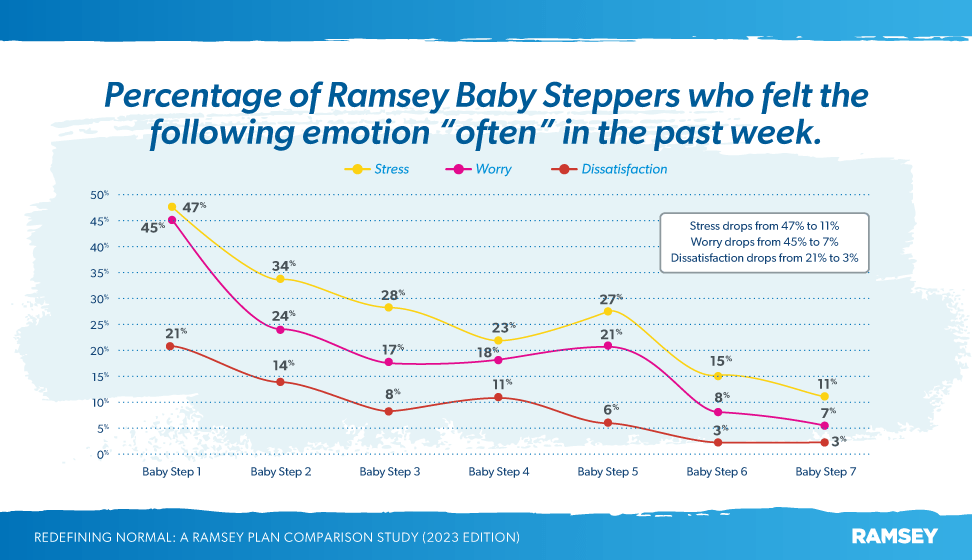
As expected, negative feelings such as stress, worry and dissatisfaction decrease as people progress through the Baby Steps. Worry drops the most—from 45% in Baby Step 1 to 7% in Baby Step 7.
It’s interesting to note that there’s a small increase in both stress and worry between Baby Steps 4 and 5 where Baby Steppers shift from shorter-term goals like paying off debt and saving an emergency fund to longer-term goals like investing for retirement, paying for college, and paying off their mortgages.
Baby Steppers Are More Optimistic About Their Money Futures
The progress people make by following the Baby Steps gives them hope that their financial futures will be brighter. Sixty-four percent of Baby Steppers are either very or extremely optimistic, compared to only 38% of the general population.
And optimism breeds confidence. While 90% of Baby Steppers said they can overcome their money challenges, only 59% of Americans said the same. Sixty-one percent say they are winning with money, compared to 36% of the general population. And 74% of Baby Steppers said they believe they can become a millionaire—an idea most Americans consider a pipe dream with only 33% of the general population believing they can reach millionaire status.
All of those factors can be distilled into a single statistic on hope: Over half of Baby Steppers (54%) are extremely hopeful that they’ll be able to achieve their money goals. Only 28% of the general population feel the same.
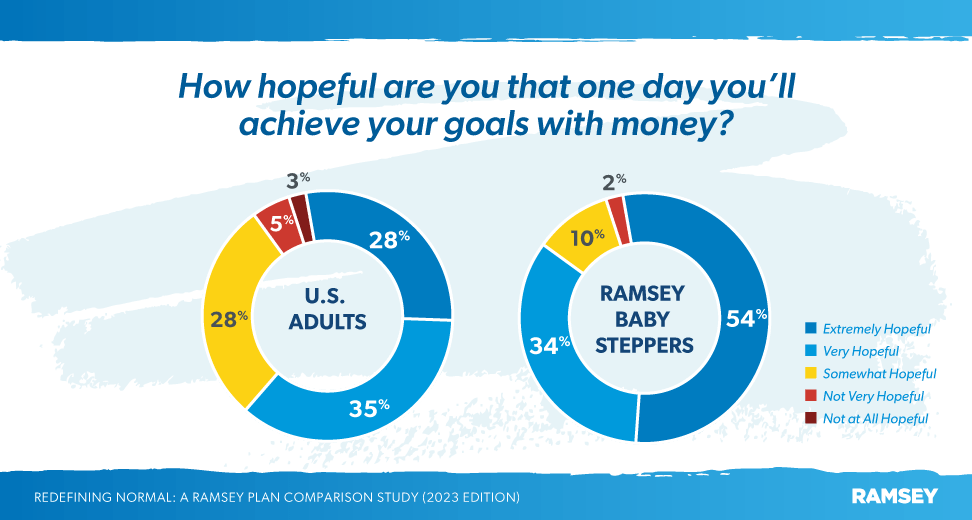
Conclusion
With most of the percentage point differences between Baby Steppers and the general population in the double digits, it’s pretty obvious that the Baby Steps work. The Ramsey program generates not just real, tangible results but also emotional, intangible changes within a person. People feel empowered and accomplished as they progress through the plan. They’re optimistic about their financial futures and are genuinely excited about building wealth and living and giving like no one else.
In today’s culture, “normal” is broke and filled with uncertainty, pessimism and fear about the future. It’s time to redefine what “normal” means and follow the Baby Steps to true financial peace.
About This Study
Redefining “Normal” is a comparison study conducted by Ramsey Solutions to find the differences in the money-related behaviors and emotional states of those who follow the Ramsey Baby Steps plan and the U.S. general population. Ramsey Solutions surveyed 1,003 U.S. adults representing the general population as well as 2,467 Baby Steppers who said they were “definitely” following the Ramsey plan. The study was sourced using samples from surveys fielded for The State of Personal Finance in America report for Q1 of 2023 from May 8 to 12, 2023, using a third-party research panel.


